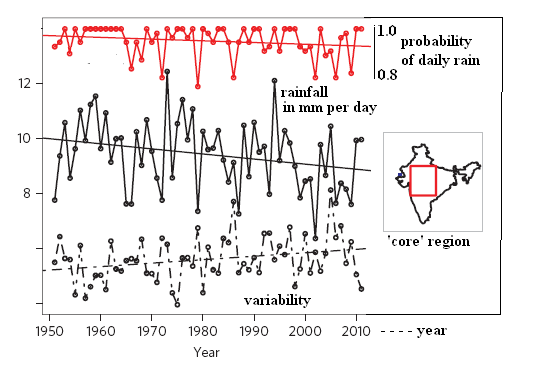The Indian summer monsoon is found to have decreased in intensity, with increased variation of wet and dry spells, over 60 years, says S.Ananthanarayanan.
The last century has seen great changes, and awareness of changes, in world climate. As a subject of great complexity, it takes wide data collection and rigorous statistical analysis to help manage the impact of changing weather conditions. The Indian monsoon affects large numbers of lives and measures to deal with events of heavy downpour or prolonged dry spells would have large economic value.
Scientists Deepti Singh, Michael Tsiang, Bala Rajaratnam and Noah S. Dffenbaugh at Stanford University, report in the journal, Nature Climate Change, that comprehensive statistical analysis of data from 1951 to 2011 reveals falling overall rainfall, with more variable daily rainfall and changes in frequency and intensity of wet and dry spells in the core monsoon region of India. “The observed changes in wet and dry extremes during the monsoon season are relevant for managing climate-related risks, with particular relevance for water resources, agriculture, disaster preparedness and infrastructure planning,” the authors of the paper say.
India receives 85% of annual rainfall during the summer monsoon. Dry spells during critical periods of soil preparation or crop growth, during the monsoon or in the winter crop season, could hence wreck agriculture, which forms the mainstay of employment and sustenance of most Indians, apart from being the base for a large part of its exports. Intense periods of rainfall could similarly lead to disasters, as in the 2005 Mumbai downpour or last year’s flooding in Uttarkhand. With changing conditions, particularly from global warming, climate extremes are likely to intensify. Hence the importance of comprehensive analyses of available data, to identify changing trends and then the underlying factors.
It is by analysis of data of temperature, humidity, and wind speed over wide areas that climate trends that were barely discernable have been studied, including the identification of global warming. Former US vice president, Al Gore got the Nobel Peace prize for his work of global warming into facus, but global warming has been studied for over a century. While the Swedish scientist Svante Arrhenius had suggested in 1896 that burning fossil fuels would increase the CO2 content of the atmosphere and lead to warming, it was in the 1930s, by detailed data collection, that it was realized that the United States and the North Atlantic had warmed significantly over the previous fifty years. This was initially dismissed as some mild, natural cycle, but one voice, of an amateur, G S Callendar, said it was the greenhouse effect. During the 1950s, with increased government funding, scientists looked at this idea with better instruments and techniques and in 1960, C D Keeling was able to show, after painstaking measurements, that the warming was due to CO2 build-up, which was increasing every year.

Climate change was intensely studied over the following decades and there were conflicting findings, either genuine or motivated, of climate changes having been the trend since millennia, of the dust levels caused by human activity causing shading and global cooling, rather than warming, etc. But data has collected and it is firmly established now, that it is the CO2 arising from human activity that is building up, with distinct rise in global temperature. Complex modeling and computer simulation have now predicted varying estimates, of 2°, 3° and 4° C as the rise in temperature by the end of the century, with different effects on sea levels, humidity, winds and rainfall. But a learning that is common is that weather is a complex subject.
Stanford group study
Central India receives high average rainfall in the monsoon season, July-August, with frequent ‘wet’ spells of intense rain, or ‘dry’ spells of no rain. The Stanford University group used rigorous statistical methods to evaluate whether the trend of extreme wet and dry spell characteristics has changed between the periods of 1851-1980 and 1981-2011.
The data used was from Indian Meteorological Department record of daily rainfall, which is developed from some 2,140 rain gauge stations distributed over the core monsoon region in the Indian subcontinent. The ‘active spells’, or intense periods, and the dry spells, or ‘breaks’, are associated with the location of convergence of atmospheric conditions, particularly air movement at and on either side of boundary layers, which bring about anomalies. Analysis of the data had thus to employ techniques to eliminate anomalies, and the result has shown a fall in the average rainfall, over the sixty year period, despite increased moisture content of the atmosphere due to warming,

At the same time, the data shows a rising trend of variability of daily rainfall. The two findings are consistent with a falling probability of rain every day, which is computed as the fraction of the days when there was at least 1mm of rainfall, as well as the higher variability in the intensity of the rain. In addition, a reduction of 2mm per day in the peak rainfall has been noted over the 1980-2011 period.
While the fall in average rainfall has already been observed and explained in different ways, the present study is the first one that has looked carefully at the record of wet and dry spells. The present analysis takes elaborate care to eliminate the effects of seasonal variations and changes in climate over the decades, and concludes that the trend is towards more intense wet spells and more frequent but less intense dry spells.
“Given the heavy dependence of agriculture on rainfall and the acute human vulnerability to flood events, the increases in dry spell frequency and wet spell intensity identified in our results represent increasing climate-related risks in the Indian subcontinent,” the authors of the paper say. Population growth, land use change and ground water depletion would aggravate risks. Although there are environmental changes that are associated with the trends identified, the underlying reasons for these trends need to be discovered to manage “evolving risks of extreme wet and dry events,” the authors say.
' ------------------------------------------------------------------------------------------